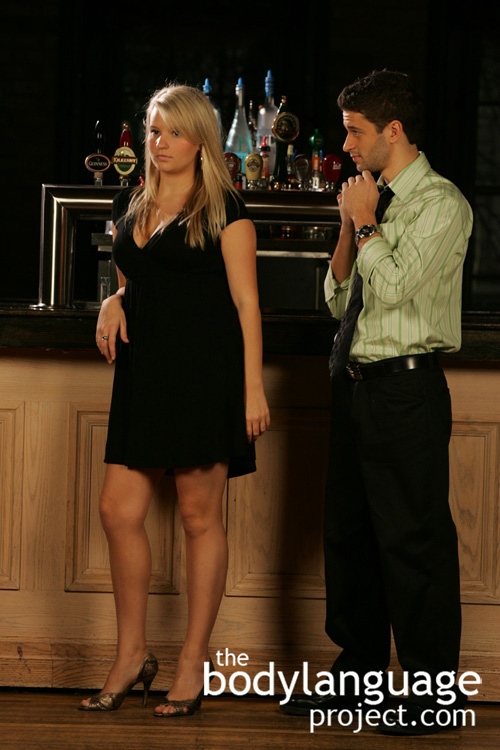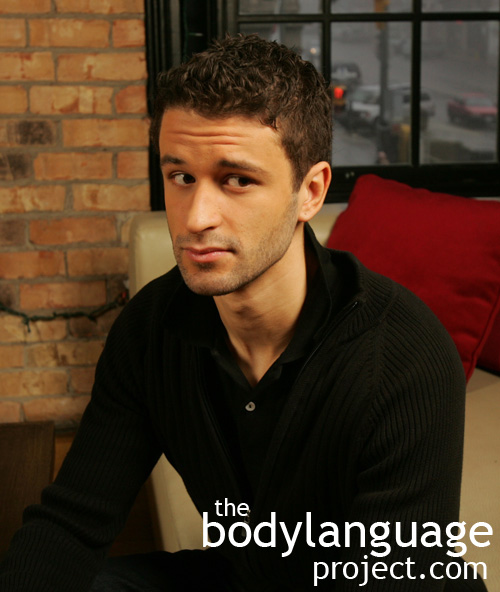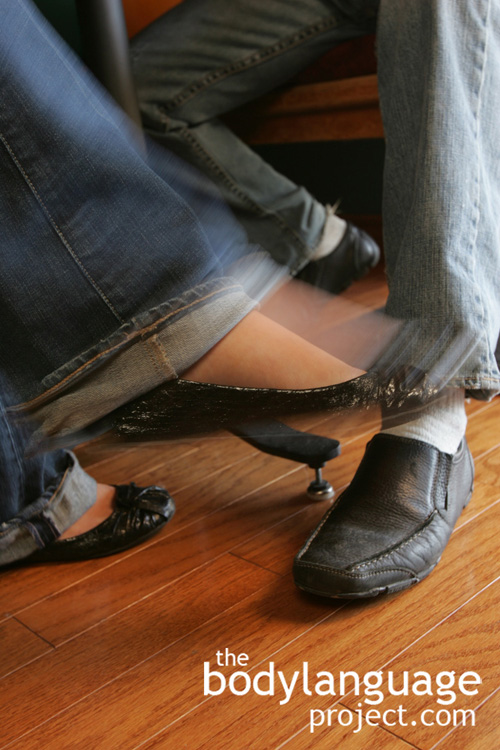Body Language of Hand Gripping Upper Arm or Wrist Behind Back
Cue: Hand Gripping Upper Arm or Wrist Behind Back.
Synonym(s): Gripping Upper Arm or Wrist Behind The Back, Wrist Gripping Behind Back, Arm Gripping Behind Back, Restraining The Self, Self Restraint.
Description: A posture where the arm is wrapped in behind the back to reach to wrist or upper arm.
In One Sentence: Gripping the upper arm behind the back is a nonverbal demonstration of holding one’s self back.
How To Use it: Use this upper arm grip behind the back cue when you want to show others that you are holding yourself back from acting out. As the cue reminds us of being restrained by a parent, it embodies the kind of self-restrained we might currently require. Therefore, the cue makes holding back easier since it reminds us of parental assistance. So if you feel that you may be spurred into an outburst, or that you need reassurance, reach up and grab your wrist or arm to create a more solid foundation to repress your thoughts or emotions. The cue is most useful when we fear that we may say something we might later regret or we need the security of being around a loved one due to insecurity.
Context: General.
Verbal Translation: “The reason I am gripping my arm or wrist behind my back is because I’m holding myself back from striking out due to my negative thoughts.”
Variant: See Arm Crossing, Hugging or The Double Arm Hug, Military Man or Regal Stance.
Cue In Action: The cop pulled her aside to speak with her about her conduct. She was so angry she was red in the face. She balled up her left hand behind her back, reached around with her right hand and clasped it rigidly preventing her from speaking or acting out on her displeasure.
Meaning and/or Motivation: The hand gripping the wrist or upper arm in behind the back sends an emotional message of frustration. It is an attempt at self-control and restraint. Therefore, it signals negative thoughts. In this case, the hand is holding the arm back preventing action from taking place due to negative emotions.
Restraint postures are part of the “freeze, flight or fight” response. When imagining this body language try picturing a toddler ready to strike at another. His mother would hold him back by the wrist or arm preventing him from doing so. This believed to the origins of the posture.
However, in adulthood, the posture is self-inflicted. We do the posture to remind us of the strength others have provided us in the past against our emotional outbursts. The posture serves to relieve tension through gripping and energy displacement. This gives us something to do to displace our negative energy.
Gripping, especially intensely, helps us feel more relaxed because the pain releases pleasure hormones and adrenaline. The same could be achieved through more constructive mechanisms like running, exercise, or constructing something useful, but like all forms of body language, the solutions come from an archaic part of the brain through evolution (or accident), so we are not interested in doing constructive work at a time when our minds are dealing with stress.
A more intense hand gripping posture happens when the arm grips higher up near the elbow or upper arm. The higher the grip, the more frustration is present and the more self-control is being expressed.
Cue Cluster: Clenching and gripping can have many other forms as well, including clenching the jaws tightly or even talking through the teeth, cracking knuckles, pulling the hair or even plucking it, pinching one’s self, and clenching the fists by turning them into a ball or wringing the hands out like a wet article of clothing.
Body Language Category: Aggressive body language, Anger, Clenching and gripping, Emotional body language, Frustration or frustrated body language, Hostile body language, Masked emotions, Negative body language.
Resources:
Borenstein, Lynn. The development of friendship in childhood: A clinical conversation. Child and Adolescent Social Work Journal. 1996. 13(3): 213-224.
Bodie, Grahamd. ; Villaume, Williama. Men and Women Holding Hands Revisited: Effects of Mutual Engagement and Hand Dominance on Attributions of Cross-Sex Handholding. Communication Research Reports. 2008. 25(4): 243-254.
Breau, Lynn M. ; Camfield, Carol S. ; Symons, Frank J. ; Bodfish, James W. ; MacKay, Alison ; Finley, G.Allen ; McGrath, Patrick J. Relation between pain and self-injurious behavior in nonverbal children with severe cognitive impairments. The Journal of Pediatrics. 2003 142(5): 498-503.
Borenstein, Lynn. The development of friendship in childhood: A clinical conversation. Child and Adolescent Social Work Journal. 1996. 13(3): 213-224.
Bodie, Grahamd. ; Villaume, Williama. Men and Women Holding Hands Revisited: Effects of Mutual Engagement and Hand Dominance on Attributions of Cross-Sex Handholding. Communication Research Reports. 2008. 25(4): 243-254.
Barroso, Felix ; Feld, Jason. Self-touching and attentional processes: The role of task difficulty, selection stage, and sex differences. Journal of Nonverbal Behavior. 1986. 10(1): 51-64.
Butzen, Nathan David ; Bissonnette, Victor ; Mcbrayer, Dan. Effects of modeling and topic stimulus on self-referent touching. Perceptual and motor skills. 2005. 101(2): 413-20.
Broome, Marion E.. Helping Parents Support Their Child In Pain. Pediatric Nursing. 2000. 26(3): 315.
Bornstein, Marc H. ; Tamis-Lemonda, Catherine S. Maternal responsiveness and infant mental abilities: Specific predictive relations. Infant Behavior and Development. 1997. 20(3): 283-296.
Buckley, V., & Semple, S. (2012). Evidence that displacement activities facilitate behavioural transitions in ring-tailed lemurs. Behavioural Processes, 90, 433–435.
Bernal, Gilda Rios ; Wortham, Suec. How to Calm Children through Massage. Childhood Education. 1997. 74(1): 9-14.
Bouhuys, A.L. ; Jansen, C.J. ; van den Hoofdakker, R.H. Analysis of observed behaviors displayed by depressed patients during a clinical interview: relationships between behavioral factors and clinical concepts of activation. Journal of Affective Disorders. 1991. 21(2): 79-88.
Bouhuys, A.L. ; Beersma, Domien G.M. ; van den Hoofdakker, Rutger H. Observed behavior as a predictor of the response to sleep deprivation in depressed patients. Psychiatry Research. 1989. 28(1): 47-61.
Berridge CW,Mitton E, ClarkW, Roth RH. 1999. Engagement in a non-escape (displacement) behavior elicits a selective and lateralized suppression of frontal cortical dopaminergic utilization in stress. Synapse 32:187–197.
Borenstein, Lynn. The development of friendship in childhood: A clinical conversation. Child and Adolescent Social Work Journal. 1996. 13(3): 213-224.
Bodie, Grahamd. ; Villaume, Williama. Men and Women Holding Hands Revisited: Effects of Mutual Engagement and Hand Dominance on Attributions of Cross-Sex Handholding. Communication Research Reports. 2008. 25(4): 243-254.
Chapell, M ; Basso, E ; Decola, A ; Hossack, J ; Keebler, J ; Marm, J ; Reed, B ; Webster, E ; Yoggev, D. Men and women holding hands: whose hand is uppermost?
Perceptual and motor skills. 1998. 87(1):127-30
Cowen, Emory L. ; Weissberg, Roger P. ; Lotyczewski, Bohdan S. Garfield, Sol L. (editor). Physical contact in interactions between clinicians and young children. Journal of Consulting and Clinical Psychology. 1983. 51(1): 132-138.
Chapell, M ; Basso, E ; Decola, A ; Hossack, J ; Keebler, J ; Marm, J ; Reed, B ; Webster, E ; Yoggev, D. Men and women holding hands: whose hand is uppermost?
Perceptual and motor skills. 1998. 87(1):127-30
Cowen, Emory L. ; Weissberg, Roger P. ; Lotyczewski, Bohdan S. Garfield, Sol L. (editor). Physical contact in interactions between clinicians and young children. Journal of Consulting and Clinical Psychology. 1983. 51(1): 132-138.
Croyle, Kristin L. ; Waltz, Jennifer. Subclinical Self-Harm: Range of Behaviors, Extent, and Associated Characteristics. American Journal of Orthopsychiatry. 2007. 77(2): 332-342.
Cowen, Emory L. ; Weissberg, Roger P. ; Lotyczewski, Bohdan S. Garfield, Sol L. (editor). Physical contact in interactions between clinicians and young children. Journal of Consulting and Clinical Psychology. 1983. 51(1): 132-138.
Caplovitz Barrett, Karen. The origins of social emotions and self-regulation in toddlerhood: New evidence. Cognition & Emotion. 2005. 19(7): 953-979.
Castles, Duncan L. ; Whiten, Andrew ; Aureli, Filippo. Social anxiety, relationships and self-directed behaviour among wild female olive baboons. Animal Behaviour. 1999. 58(6): 1207-1215.
D’alessio, M. ; Zazzetta, A. Development of Self-Touching Behavior in Childhood. Perceptual and Motor Skills. 1986. 63(1): 243-253.
Flores, Luis E. ; Berenbaum, Howard. Desire for emotional closeness moderates the effectiveness of the social regulation of emotion. Personality and Individual Differences
Gulledge, Andrewk. ; Gulledge, Michelleh. ; Stahmannn, Robertf.. Romantic Physical Affection Types and Relationship Satisfaction. The American Journal of Family Therapy. 2003. 31(4): 233-242.
Gulledge, Andrew K ; Stahmann, Robert F ; Wilson, Colwick M. Seven types of nonsexual romantic physical affection among Brigham young university students. Psychological reports. 2004. 95(2): 609-14.
Goldberg, Shelly ; Rosenthal, Robert. Self-touching behavior in the job interview: Antecedents and consequences. Journal of Nonverbal Behavior. 1986. 10(1): 65-80.
Hernandez-Reif, Maria ; Diego, Miguel ; Field, Tiffany. Preterm infants show reduced stress behaviors and activity after 5 days of massage therapy. Infant Behavior and Development. 2007. 30(4): 557-561.
Harrison, Lynda Law. The use of comforting touch and massage to reduce stress for preterm infants in the neonatal intensive care unit. Newborn and Infant Nursing Reviews. 2001. 1(4): 235-241.
Hennessy, Michael B ; T. Williams, Michael ; Miller, Deborah D ; Douglas, Chet W ; Voith, Victoria L. Influence of male and female petters on plasma cortisol and behaviour: can human interaction reduce the stress of dogs in a public animal shelter?
Applied Animal Behaviour Science. 1998. 61(1): 63-77.
Harrigan, Jinni A. Self-touching as an indicator of underlying affect and language processes. Social Science & Medicine. 1985. 20(11): 1161-1168.
Harrigan, Jinni A.; Karen S. Lucic; Denise Kay; Anne McLaney and Robert Rosenthal. Effect of Expresser Role and Type of Self-Touching on Observers’ Perceptions. Journal of Applied Social Psychology. 1991. 21(7): 585-609.
Heaven, Laura ; Mcbrayer, Dan ; Prince, Bob. Role of sex in externally motivated self-touching gestures. Perceptual and motor skills. 2002. 95(1): 289-94.
Heaven, L ; Mcbrayer, D. External motivators of self-touching behavior. Perceptual and motor skills. 2000. 90(1): 338-42.
Hung, Iris W. and Aparna A. Labroo. From Firm Muscles to Firm Willpower: Understanding the Role of Embodied Cognition in Self-Regulation. Journal of Consumer Research. 2011 37(6): 1046-1064. http://www.jstor.org/stable/10.1086/657240
http://bodylanguageproject.com/articles/firm-muscles-lead-willpower/
Johnson, Bret K. ; Kenkel, Mary Beth. Stress, coping, and adjustment in female adolescent incest victims. Child Abuse & Neglect. 1991. 15(3): 293-305.
Kirschbaum C, Pirke K-M, Hellhammer DH. 1993. The ‘Trier Social Stress Test’: a tool for investigating psychobiological stress responses in a laboratory setting. Neuropsychobiology 28: 76–81.
Kochanska, G., Coy, K. C., & Murray, K. T. (2001). The development of self-regulation in the first four years of life. Child Development, 72, 1091–1111.
Kochanska, G., Murray, K. T., & Harlan, E. T. (2000). Effortful control in early childhood: Continuity and change, antecedents, and implications for social development. Developmental Psychology, 36, 220–232.
Kammers, Marjolein P.M. ; de Vignemont, Frédérique ; Haggard, Patrick. Cooling the Thermal Grill Illusion through Self-Touch. Current Biology. 2010. 20(20): 1819-182.
Moszkowski, Robin J. ; Stack, Dale M. ; Chiarella, Sabrina S. Infant touch with gaze and affective behaviors during mother–infant still-face interactions: Co-occurrence and functions of touch. Infant Behavior and Development. 2009. 32(4): 392-403.
Maestripieri D, Schino G, Aureli F, Troisi A. 1992. A modest proposal: displacement activities as an indicator of emotions in primates. Anim Behav 44:967–979.
Mohiyeddini, C., Bauer, S., & Semple, S. (2013a). Displacement behaviour is associated with reduced stress levels among men but not women. PLoS One, 8, e56355.
Mohiyeddini, C., Bauer, S., & Semple, S. (2013b). Public self-consciousness moderates the link between displacement behaviour and experience of stress in women. Stress, 16, 384–392.
Mohiyeddini, C., & Semple, S. (2013). Displacement behaviour regulates the experience of stress in men. Stress, 16, 163–171.
Marcus-Newhall A, Pedersen WC, Carlson M, Miller N. 2000. Displaced aggression is alive and well: a meta-analytic review. J Pers Soc Psychol 78:670–689. Ingram GIC. 1960. Displacement activity in human behavior. Am Anthropol. 62:994–1003.
Nolen-Hoeksema S, Aldao A (2011) Gender and age differences in emotion regulation strategies and their relationship to depressive symptoms. Personal Indiv Diff 51: 704–8.
Navarro, Joe. 2008. What Every BODY is Saying: An Ex-FBI Agent’s Guide to Speed-Reading People. William Morrow Paperbacks.
Nock, Matthew K. Actions speak louder than words: An elaborated theoretical model of the social functions of self-injury and other harmful behaviors. Applied and Preventive Psychology. 2008. 12(4): 159-168.
O’sullivan, Lucia F. ; Cheng, Mariah Mantsun ; Harris, Kathleen Mullan ; Brooks-gunn, Jeanne. I Wanna Hold Your Hand: The Progression of Social, Romantic and Sexual Events in Adolescent Relationships. Perspectives on Sexual and Reproductive Health. 2007. 39(2): 100-107.
Pettijohn, Terry F. , Ii ; Ahmed, Shujaat F. ; Dunlap, Audrey V. ; Dickey, Lauren N. Who’s got the upper hand? Hand holding behaviors among romantic couples and families.(Report). Current Psychology. 2013. 32(3): 217(4).
Pease, Barbara and Allan Pease. 2006. The Definitive Book of Body Language Hardcover. Bantam.
Pecora, Giulia ; Addessi, Elsa ; Schino, Gabriele ; Bellagamba, Francesca. Do displacement activities help preschool children to inhibit a forbidden action? Journal of Experimental Child Psychology. 2014. 126: 80-90.
Rubin, Mark Morrison, Todd G. (editor). Social Affiliation Cues Prime Help-Seeking Intentions. Canadian Journal of Behavioural Science/Revue canadienne des sciences du comportement. 2011. 43(2): 138-141.
Rosenbloom, Tova ; Ben-Eliyahu, Adar ; Nemrodov, Dan. Children’s crossing behavior with an accompanying adult. Safety Science. 2008. 46(8): 1248-1254.
Rubin, Mark Morrison, Todd G. (editor). Social Affiliation Cues Prime Help-Seeking Intentions. Canadian Journal of Behavioural Science/Revue canadienne des sciences du comportement. 2011. 43(2): 138-141.
Schaafsma, Juliette ; Krahmer, Emiel ; Postma, Marie ; Swerts, Marc ; Balsters, Martijn ; Vingerhoets, Ad. Comfortably Numb? Nonverbal Reactions to Social Exclusion. Journal of Nonverbal Behavior. 2015. 39(1): 25-39.
Schino G, Perretta G, Taglioni AM, Monaco V, Troisi A. 1996. Primate displacement activities as an ethopharmacological model of anxiety. Anxiety 2:186–191.
Supplee, Lauren H ; Skuban, Emily Moye ; Shaw, Daniel S ; Prout, Joanna. Emotion regulation strategies and later externalizing behavior among European American and African American children. Development and Psychopathology. 2009. 21(2): 393-415.
Tamres L, Janicki D, Helgeson VS (2002) Sex differences in coping behaviour: a meta-analytic review. Personal Soc Psychol Rev 6: 2–30.
Troisi A (2002) Displacement activities as a behavioural measure of stress in nonhuman primates and human subjects. Stress 5: 47–54.
Troisi A (1999) Ethological research in clinical psychiatry: the study of nonverbal behaviour during interviews. Neurosci Biobehav Rev 23: 905–913.
Troisi A, Moles A (1999) Gender differences in depression: an ethological study of nonverbal behaviour during interviews. J Psychiatr Res 33: 243–250.
Toronto, Ellen L.K. A clinician’s response to physical touch in the psychoanalytic setting. International Journal of Psychotherapy. 2002 7(1): 69-81.
Williams, Trish ; Connolly, Jennifer ; Cribbie, Robert. Light and Heavy Heterosexual Activities of Young Canadian Adolescents: Normative Patterns and Differential Predictors.(Author abstract)(Report). Journal of Research on Adolescence. 2008. 18(1): 145(28).
Yu, Yawen ; Bardy, Benoit G ; Stoffregen, Thomas A. Influences of head and torso movement before and during affordance perception. Journal of motor behavior. 2011. 43(1): 45-54.
von Hippel W, von Hippel C, Conway L, Preacher KJ, Schooler JW, et al. (2005) Coping with stereotype threat: denial as an impression management strategy. J Personal Soc Psychol 89: 22–35.








